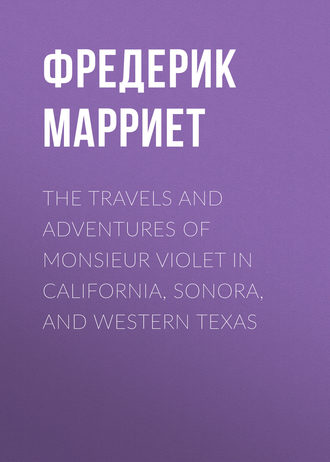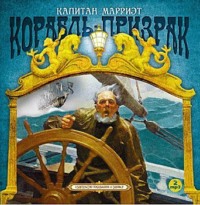 полная версия
полная версияThe Travels and Adventures of Monsieur Violet in California, Sonora, and Western Texas
We passed the Buona Ventura, and followed the track of our white men for upwards of 200 miles, when we not only could trace it no further, but found our small party of fifteen surrounded by about eighty of our implacable enemies, the Crows.
By stratagem, we not only broke through them, but succeeded in surprising seven of their party. My companions would have put them to death, but I would not permit it. We secured them on their own horses, and made all the haste we could, but the Crows had discovered us and gave chase.
It was fifteen days' travelling to our own country, and we were pursued by an enemy seven or eight times superior to us In numbers. By various stratagems, which I shall not dwell upon, aided by the good condition of our horses, we contrived to escape them, and to bring our prisoners safe into the settlement. Now, although we had no fighting, yet address is considered a great qualification. On my return I was therefore admitted as a chief, with the Indian name Owato Wanisha, or "spirit of the beaver," as appropriate to my cunning and address. To obtain the rank of a warrior chief, it was absolutely requisite that I had distinguished myself on the field of battle.
Before I continue my narration, I must say a little more relative to the missionaries, who were my instructors. One of them, the youngest, Polidori, was lost in the Esmeralda, when she sailed for Monterey to procure cattle. The two others were Padre Marini and Padre Antonio. They were both highly accomplished and learned. Their knowledge in Asiatic lore was unbounded, and it was my delight to follow them in their researches and various theories concerning the early Indian emigration across the waters of the Pacific.
They were both Italians by birth. They had passed many years of their lives among the nations west of the Ganges, and in their advanced years had returned to sunny Italy, to die near the spot where they had played as little children. But they had met with Prince Seravalle, and when they heard from him of the wild tribes with whom he had dwelt, and who knew not God, they considered that it was their duty to go and instruct them.
Thus did these sincere men, old and broken, with one foot resting on their tombs, again encounter difficulties and danger, to propagate among the Indians that religion of love and mercy which they were appointed to make known.
Their efforts, however, to convert the Shoshones were fruitless. Indian nature would seem to be a nature apart and distinct. The red men, unless in suffering or oppression, will not listen to what they call "the smooth honey words of the pale-faced sages;" and even when they do so, they argue upon every dogma and point of faith, and remain unconvinced. The missionaries, therefore, after a time, contented themselves with practising deeds of charity, with alleviating their sufferings when able, from their knowledge of medicine and surgery, and by moral precepts, softening down as much as they could the fierce and occasionally cruel tempers of this wild untutored race.
Among other advantages which the Shoshones derived from our missionaries, was the introduction of vaccination. At first it was received with great distrust, and indeed violently opposed, but the good sense of the Indians ultimately prevailed: and I do not believe that there is one of the Soshones born since the settlement was formed who has not been vaccinated: the process was explained by the Padres Marini and Polidori to the native medical men, and is now invariably practised by them.
I may as well here finish the histories of the good missionaries. When I was sent upon an expedition to Monterey, which I shall soon have to detail, Padre Marini acccompanied me. Having failed with the Shoshones, he considered that he might prove useful by locating himself in the Spanish settlements of California. We parted soon after we arrived at Monterey, and I have never seen or heard of him since. I shall, however, have to speak of him again during our journey and sojourn at that town.
The other, Padre Antonio, died at the settlement previous to my journey to Monterey, and the Indians still preserve his robes, missal, and crucifix, as the relics of a good man. Poor Padre Antonio! I would have wished to have known the history of his former life. A deep melancholy was stamped upon his features, from some cause of heart-breaking grief, which even religion could but occasionally assuage, but not remove.
After his death, I looked at his missal. The blank pages at the beginning and the end were filled up with pious reflections, besides some few words, which spoke volumes as to one period of his existence. The first words inscribed were; "Julia, obiit A.D. 1799. Virgo purissima, Maris Stella. Ora pro me." On the following leaf was written: "Antonio de Campestrina, Convient. Dominicum. in Româ, A.D. 1800."
Then he had embraced a monastic life upon the death of one dear to him–perhaps his first and only love. Poor man! many a time have I seen the big burning tears rolling fast down his withered cheeks. But he is gone, and his sorrows are at rest On the last page of the missal were also two lines, written in a tremulous hand, probably a short time previous to his death: "I, nunc anima anceps; sitque tibi Deus misericors."
The Prince Seravalle did not, however, abandon his plans; having failed in persuading the Shoshones, at the suggestion of my father, it was resolved that an attempt should be made to procure a few Mexicans and Canadians to carry on the agricultural labours; for I may here as well observe, that both the Prince and my father had long made up their minds to live and die among the Indians.
This expedition was to be undertaken by me. My trip was to be a long one. In case I should not succeed in Monterey in enlisting the parties required, I was to proceed on to Santa Fé, either with a party of Apaches Indians, who were always at peace with the Shoshones, or else with one of the Mexican caravans.
In Santa Fé there were always a great number of French and Canadians, who came every year from St. Louis, hired by the Fur Companies; so that we had some chance of procuring them. If, however, my endeavours should prove fruitless, as I should already have proceeded too far to return alone, I was to continue on from Santa Fé with the fur traders, returning to St. Louis, on the Mississippi, where I was to dispose of some valuable jewels, hire men to form a strong caravan, and return to the settlement by the Astoria trail.
As my adventures may be said but to commence at my departure upon this commission, I will, before I enter upon my narrative, give the reader some insight into the history and records of the Shoshones, or Snake Indians, with whom I was domiciled, and over whom, although so young, I held authority and command.
CHAPTER IV
The Shoshones, or Snake Indians, are a brave and numerous people, occupying a large and beautiful tract of country, 540 miles from east to west, and nearly 300 miles from north to south. It lies betwixt 38° and 43° north latitude, and from longitude 116° west of Greenwich to the shores of the Pacific Ocean, which there extend themselves to nearly the parallel of 125° west longitude. The land is rich and fertile, especially by the sides of numerous streams, where the soil is sometimes of a deep red colour, and at others entirely black. The aspect of this region is well diversified, and though the greatest part of it must be classified under the denomination of rolling prairies, yet woods are very abundant, principally near the rivers and in the low flat bottoms: while the general landscape is agreeably relieved from the monotony of too great uniformity by numerous mountains of fantastical shapes and appearance, entirely unconnected with each other, and all varying in the primitive matter of their conformation.
Masses of native copper are found at almost every step, and betwixt two mountains which spread from east to west in the parallel of the rivers Buona Ventura and Calumet, there are rich beds of galena, even at two or three feet under ground; sulphur and magnesia appear plentiful in the northern districts; while in the sand, of the creeks to the south gold dust is occasionally collected by the Indians. The land is admirably watered by three noble streams–the Buona Ventura, the Calumet, and the Nú elejé sha wako, or River of the Strangers, while twenty rivers of inferior size rush with noise and impetuosity from the mountains, until they enter the prairies, where they glide smoothly in long serpentine courses between banks covered with flowers and shaded by the thick foliage of the western magnolia. The plains, as I have said, are gently undulating, and are covered with excellent natural pastures of moskito-grass, blue grass, and clover, in which innumerable herds of buffaloes, and mustangs, or wild horses, graze, except during the hunting season, in undisturbed security.
The Shoshones6 are indubitably a very ancient people. It would be impossible to say how long they may have been settled on this portion of the continent. Their cast of features proves them to be of Asiatic origin, and their phraseology, elegant and full of metaphors, assumes all the graceful variety of the brightest pages of Saadi.
A proof of their antiquity and foreign extraction is, that but few of their records and traditions are local; they refer to countries on the other side of the sea, countries where the summer is perpetual, the population numberless, and the cities composed of great palaces, like the Hindoo traditions, "built by the good genii, long before the creation of man."
There is no doubt, indeed it is admitted by the other tribes that the Shoshone is the parent tribe of the Comanches, Arrapahoes, and Apaches–the Bedouins of the Mexican deserts. They all speak the same beautiful and harmonious language, have the same traditions; and indeed so recent have been their subdivisions, that they point out the exact periods by connecting them with the various events of Spanish inland conquest in the northern portion of Sonora.
It is not my intention to dwell long upon speculative theory, but I must observe, that if any tradition is to be received with confidence it must proceed from nations, or tribes, who have long been stationary. That the northern continent of America was first peopled from Asia, there can be little doubt, and if so, it is but natural to suppose that those who first came over would settle upon the nearest and most suitable territory. The emigrants who, upon their landing, found themselves in such a climate and such a country as California, were not very likely to quit it in search of a better.
That such was the case with the Shoshones, and that they are descendants from the earliest emigrants, and that they have never quitted the settlement made by their ancestors, I have no doubt, for all their traditions confirm it.
We must be cautious how we put faith in the remarks of missionaries and travellers upon a race of people little known. They seldom come into contact with the better and higher classes, who have all the information and knowledge; and it is only by becoming one of them, not one of their tribes, but one of their chiefs, and received into their aristocracy, that any correct intelligence can be gained.
Allow that a stranger was to arrive at Wapping, or elsewhere, in Great Britain, and question those he met in such a locality as to the religion, laws, and history of the English, how unsatisfactory would be their implies; yet missionaries and travellers among these nations seldom obtain farther access. It is therefore among the better classes of the Indians that we must search for records, traditions, and laws. As for their religion, no stranger will ever obtain possession of its tenets, unless he is cast among them in early life and becomes one of them.
Let missionaries say what they please in their reports to their societies, they make no converts to their faith, except the pretended ones of vagrant and vagabond drunkards, who are outcasts from their tribes.
The traditions of the Shoshones fully bear out my opinion that they were among the earliest of the Asiatic emigrants; they contain histories of subsequent emigrations, in which they had to fight hard to retain their lands; of the dispersion of the new emigrants to the north and south; of the increase of numbers, and breaking up of portions of the tribes, who travelled away to seek subsistence in the East.
We find, as might be expected, that the traditions of the Eastern tribes, collected as they have occasionally been previous to their extinction, are trifling and absurd; and why so? because, driven away to the east, and finding other tribes of Indians, who had been driven there before them, already settled there, they have immediately commenced a life of continual hostility and change of domicile. When people have thus been occupied for generations in continual warfare and change, it is but natural to suppose that in such a life of constant action they have had no time to transmit then traditions, and that ultimately they have been lost to the tribe.
We must then look for records in those quarters where the population has remained stationary for ages. It must be in the south-west of Oregon, and in the northern parts of Upper California and Sonora, that the philosopher must obtain the eventful history of vast warlike nations, of their rise and of their fall. The western Apaches or the Shoshones, with their antiquities and ruins of departed glory, will unfold to the student's mind long pages of a thrilling interest, while in their metaphors and rich phraseology, the linguist, learned in Asiatic lore, will easily detect their ancient origin.
It is remarkable to observe, how generally traditions and records will spread and be transmitted among nations destitute of the benefits of the art of printing. In Europe, the mass were certainly better acquainted with their ancient history before this great discovery that they are in our days, as traditions were then handed down from family to family–it was a duty, a sacred one, for a father to transmit them to his son, unadulterated, such, in fact, as he had received them from his ancestors. It is the same case with the Indians, who have remained stationary for a long period. It is in the long evenings of February, during the hunting seasons that the elders of the tribe will reveal to the young warriors all the records of their history; and were a learned European to assist at one of these "lectures upon antiquity," he would admit that, in harmony, eloquence, strength of argument, and deduction, the red-coloured orator could not easily be surpassed.
The Shoshones have a clear and lucid recollection of the far countries whence they have emigrated. They do not allude to any particular period, but they must have been among the first comers, for they relate with great topographical accuracy all the bloody struggles they had to sustain against newer emigrants. Often beaten, they were never conquered, and have always occupied the ground which they had selected from the beginning.
Unlike the great families of the Dahcotahs and Algonquins, who yet retain the predominant characteristics of the wandering nations of South-west Asia, the Shoshones seem to have been in all ages a nation warlike, though stationary. It is evident that they never were a wealthy people, nor possessed any great knowledge of the arts and sciences. Their records of a former country speak of rich mountainous districts, with balmy breezes, and trees covered with sweet and beautiful fruits; but when they mention large cities, palaces, temples, and gardens, it is always in reference to other nations, with whom they were constantly at war; and these traditions would induce us to believe that they are descendants of the Mancheoux Tartars.
They have in their territory on both sides of the Buona Ventura river many magnificent remains of devastated cities; but although connected with a former period of their history, they were not erected by the Shoshones.
The fountains, aqueducts, the heavy domes, and the long graceful obelisks, rising at the feet of massive pyramids, show indubitably the long presence of a highly civilized people; and the Shoshones' accounts of these mysterious relics may serve to philosophers as a key to the remarkable facts of thousands of similar ruins found everywhere upon the continent of America. The following is a description of events at a very remote period, which was related by an old Shoshone sage, in their evening encampment in the prairies, during the hunting season:–
"It is a long, long while! when the wild horses were unknown in the country7, and when the buffalo alone ranged the vast prairies then huge and horrid monsters existed. The approaches of the mountains and forests were guarded by the evil spirits8, while the seashore, tenanted by immense lizards,9 was often the scene of awful conflicts between man, the eldest son of light, and the mighty children of gloom and darkness. Then, too, the land we now live in had another form; brilliant stones were found in the streams; the mountains had not yet vomited their burning bowels, and the great Master of Life was not angry with his red children.
"One summer, and it was a dreadful one, the moon (i.e. the sun) remained stationary for a long time; it was of a red blood colour, and gave neither night nor days. Takwantona, the spirit of evil, had conquered Nature, and the sages of the Shoshones foresaw many dire calamities. The great Medecines declared that the country would soon be drowned in the blood of their nation. They prayed in vain, and offered, without any success, two hundred of their fairest virgins in sacrifice on the altars of Takwantona. The evil spirit laughed, and answered to them with his destructive thunders. The earth was shaken and rent asunder; the waters ceased to flow in the rivers, and large streams of fire and burning sulphur rolled down from the mountains, bringing with them terror and death. How long it lasted none is living to say; and who could? There stood the bleeding moon; 'twas neither light nor obscurity; how could man divide the time and the seasons? It may have been only the life of a worm; it may have been the long age of a snake.
"The struggle was fearful, but at last the good Master of Life broke his bonds. The sun shone again. It was too late! the Shoshones had been crushed and their heart had become small; they were poor and had no dwellings; they were like the deer of the prairies, hunted by the hungry panther.
"And a strange and numerous people landed on the shores of the sea: they were rich and strong; they made the Shoshones their slaves, and built large cities, where they passed all their time. Ages passed: the Shoshones were squaws; they hunted for the mighty strangers; they were beasts, for they dragged wood and water to their great wigwams; they fished for them, and they themselves starved in the midst of plenty. Ages again passed: the Shoshones could bear no more; they ran away to the woods, to the mountains, and to the borders of the sea; and, lo! the great Father of Life smiled again upon them; the evil genii were all destroyed, and the monsters buried in the sands.
"They soon became strong, and great warriors; they attacked the strangers, destroyed their cities, and drove them like buffaloes, far in the south, where the sun is always burning, and from whence they did never return.
"Since that time, the Shoshones have been a great people. Many, many times strangers arrived again; but being poor and few, they were easily compelled to go to the east and to the north, in the countries of the Crows, Flat-heads, Wallah Wallahs, and Jal Alla Pujees (the Calapooses)."
I have selected this tradition out of many, as, allowing for metaphor, it appears to be a very correct epitome of the history of the Shoshones in former times. The very circumstance of their acknowledging that they were, for a certain period, slaves to that race of people who built the cities, the ruins of which still attest their magnificence, is a strong proof of the outline being correct. To the modern Shoshones, and their manners and customs, I shall refer in a future portion of my narrative.
CHAPTER V
Every point having been arranged, I received my final instructions, and letters for the Governor of Monterey, to which was added a heavy bag of doubloons for my expenses. I bade farewell to the Prince and my father, and with six well-armed Indians and the Padre Marini, I embarked in a long canoe on the Buona Ventura river, and carried away by the current, soon lost sight of our lonesome settlement.
We were to follow the stream to the southern lakes of the Buona Ventura, where we were to leave our Indians, and join some half-bred Wachinangoes, returning to Monterey, with the mustangs, or wild horses, which they had captured in the prairies.
It was a beautiful trip, just at the commencement of the spring; both shores of the river were lined with evergreens; the grass was luxuriant and immense herds of buffaloes and wild horses were to be seen grazing in every direction. Sometimes a noble stallion, his long sweeping mane and tail waving to the wind, would gallop down to the water's edge, and watch us as if he would know our intentions. When satisfied, he would walk slowly back, ever and anon turning round to look at us again, as if not quite so convinced of our peaceful intentions.
On the third night we encamped at the foot of an obelisk, in the centre of some noble ruins. It was a sacred spot with the Shoshones. Their traditions told them of another race, who had formerly lived there, and which had been driven by them to the south. It must have been ages back, for the hand of time, so lenient in this climate, and the hand of man, so little given to spoil, had severely visited this fated city.
We remained there the following day, as Padre Marini was anxious to discover any carvings or hieroglyphics from which he might draw some conclusions; but our endeavours were not successful, and we could not tarry longer, as we were afraid that the horse-hunters would break up their encampments before we arrived. We, therefore, resumed our journey, and many were the disquisitions and conjectures which passed between me and the holy father, as to the high degree of civilization which must have existed among the lost race who had been the architects of such graceful buildings.
Four days more brought us to the southern shore of the St. Jago lake. We arrived in good time, dismissed our Indians, and having purchased two excellent mules, we proceeded on our journey, in company with the horse-hunters, surrounded by hundreds of their captives, who were loudly lamenting their destiny, and showed their sense of the injustice of the whole proceeding by kicking and striking with their fore-feet at whatever might come within the reach of their hoofs. Notwithstanding the very unruly conduct of the prisoners, we arrived at Monterey on the sixth evening.
The reader will discover, as he proceeds, that my adventures are about to commence from this journey to Monterey; I therefore wish to remind him that I was at this time not eighteen years old. I had a remembrance of civilization previous to my arrival among the Indians, and as we enjoyed every comfort and some luxuries at the settlement, I still had a remembrance, although vague, of what had passed in Italy and elsewhere. But I had become an Indian, and until I heard that I was to under-take this journey, I had recollected the former scenes of my youth only to despise them.
That this feeling had been much fostered by the idea that I should never again rejoin them, is more than probable; for from the moment that I heard that I was to proceed to Monterey, my heart beat tumultuously and my pulse was doubled in its circulation. I hardly know what it was that I anticipated, but certainly I had formed the idea of a terrestrial paradise.
If not exactly a paradise, Monterey is certainly a sweet place; 'tis even now a fairy spot in my recollection, although sobered down, and, I trust, a little wiser than I was at that time. There certainly is an air of happiness spread over this small town. Every one is at their ease, everybody sings and smiles, and every hour is dedicated to amusement or repose.
None of your dirty streets and sharp pavements; no manufactories with their eternal smoke; no policemen looking like so many knaves of clubs; no cabs or omnibuses splashing the mud to the right and to the left; and, above all, none of your punctual men of business hurrying to their appointments, blowing like steam-engines, elbowing everybody, and capsizing the apple-stalls. No; there is none of these at Monterey.









